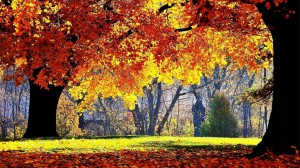Why do trees drop their leaves ?

As the seasons roll around we accept it as a natural part of life; Autumn arrives, the days get shorter and the leaves fall from the trees. But why is it this way? Why do trees drop the very means by which they gain sustenance? Why not just hang on to them at least until the new Spring growth ?
The Way it is
It’s worth pointing out before we start, even if it is ‘obvious’, that not all trees drop their leaves. Trees that don’t drop their leaves are called evergreens and trees that do drop all their leaves at once are called deciduous (from the Latin for ‘falling down’). In addition some evergreens, such as trees in tropical rainforests, do drop their leaves, but not all at once. So really there are two questions here.
» Firstly, why does any tree ever drop a leaf ? » Secondly, why do some trees drop all their leaves at once ?
Why does any tree ever drop a leaf ?
Keeping a leaf alive costs energy. But so does letting one drop off, since whatever nutrients are left in the leaf when it falls will be lost to the tree. A tree drops a leaf when it will cost more to keep it alive than to let it fall. This is a bit like having a car; usually it will be cheaper to keep repairing the car you have, rather than buying a new one. But when the car gets to a certain point, it may be cheaper in the long run to scrap it and get a new one.
Why do some trees drop all their leaves at once? ?
During dry seasons or cold, dark winters, the cost of keeping a leaf alive goes up, while the amount of photosynthesis it can do goes down. Photosynthesis depends on water and light, and as the temperature drops so does the rate of photosynthesis (see our article on How do plants feed ?). For many trees living in the north or south, by the time autumn comes it is simply not worth holding on to their leaves. This is especially true for broadleaf trees, which have big, fragile leaves that can be damaged by frost. So deciduous trees decide to cut and run, or in other words, drop all their leaves at once. A full-grown tree can have more than 200,000 leaves, and over the course of about 60y years will drop over 1.5 tonnes of leaves. Worldwide there are more than 400 billion trees (about sixty for every human being on the planet), so that adds up to a lot of leaves.
When a tree decides that it will be cheaper in the long run to scrap one of its leaves, it drains as many nutrients as possible out of the leaf before cutting it off at the base. The order in which these nutrients are drained is what makes leaves change colour.
Leaves are green because they have a lot of chlorophyll to help them harvest blue and red light during photosynthesis, but they also have other types of pigment to help them harvest other colours of light. These pigments include xanthophylls (which are yellow) and carotenoids (which are yellow, orange and red). Because chlorophyll is the most valuable of these pigments, it gets drained out of the leaf first, leaving the other colours behind, and so leaves turn red, orange and yellow. Eventually even these colours are drained, leaving just tannins, which are brown.
So there you are, trees are clever enough to ‘know’ when its better to ‘cut and run’ because the cost of keeping their leaves outweighs the benefits.






